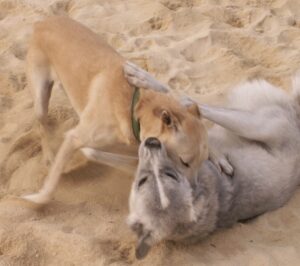Barks Blog
Pet Professionals: Keeping It Objective

A dog’s behavior can many times cause the owner to experience feelings of embarrassment or even failure. Such feelings can be detrimental in the trainer/behavior consultant-client relationship and can certainly adversely affect the outcome of any training protocols that are put into place. When owners shut down or withhold information, behavior professionals will lack the necessary information with which to proceed. Yet while information obtained from an owner can be patchy, subjective, and even anthropomorphic in nature, owners are in fact the greatest source of information regarding their animal’s behavior and personality.
For this reason it is essential that the behavior consultant or trainer open and non-judgmental to what is divulged by the client. Professionals in this industry must be constantly self-monitoring with regard to comments and body language, while also employing the use of appropriate language (see Landsberg, Hunthausen & Ackerman, 2008). Openness, warmth, and understanding will go quite far in easing the anxiety that a client may feel as a result of the behaviors that their dog is exhibiting. Ultimately, the client will be more likely to respond in an accepting manner to new training procedures and educational materials.
In obtaining history and pertinent information from a client, it is important for the behavior professional to act as a guide. The information obtained from the client must be accurate and the professional should not lead a client to any particular answer. As a result, it is crucial to consider one’s terminology in designing a questionnaire. Karen Overall (2008) suggests that rather than being overly concerned with using those terms used by our professional cohorts, it may be more important to be able to describe one’s own behavioral terms to others. One method of doing so is by offering closed-ended and/or multiple choice questions. Using an open-ended question such as “When does the problem behavior occur?” may yield answers that are subjective and/or anthropomorphic in nature. For example, a client might answer that a particular behavior occurs when Rex gets mad. The behavior may occur in reality because when the owner is locking Rex up for extended periods of time, Rex’s welfare is compromised, resulting in unwanted behaviors. Therefore, it may be more appropriate to ask questions like: “How many hours per day is the dog crated/locked up?” This question would yield a numerical value, which is objective in nature. Alternatively, the behavior professional may offer a multiple choice answer: 0-1 hours, 2-4 hours, 5-7 hours, 8-10 hours, more than 10 hours.
Similarly a behavior checklist would provide important and objective information regarding the behavior. For example, in listing attention related behaviors, one might provide a Lickert scale alongside a description of the behavior:
Behavior Rating
Constantly demands attention 0-1-2-3-4-5
Pushy, disobedient, hard to train 0-1-2-3-4-5
Poor with commands 0-1-2-3-4-5
Possessive with toys 0-1-2-3-4-5
Poor on lead 0-1-2-3-4-5
Does not settle 0-1-2-3-4-5
Jumps on people 0-1-2-3-4-5
…and so on.
Tami and Gallagher found great success in the human interpretation of a dog’s state of mind, regardless of the human’s experience with canines. The most recognizable states of mind were accurately labeled as “indifference, fear, friendliness and play solicitation.” (Tami & Gallagher, 2009). What is remarkable is that while feedback was anthropomorphic (he feels, she thinks, etc.), the descriptions of the behavior still managed to fit accurately with the dog’s state of mind. So let’s not throw the proverbial baby out with the bathwater. The language presented by the owner versus the objective information necessary to treatment and training brings the professional to a notably gray area. As Karen Overall notes, there can be a huge misuse of the word “aggression” due to a variety of interpretations amongst both laypeople and professionals. She recommends steering clear of this term in the professional setting (Overall, 2008) – and this is only one single term!
Ultimately, the behavior consultant or trainer must be listening for the most accurate description of the behavior. In the article “Terminology Think Tank: Pathogenesis and modeling,” Palestrini notes that the behavior professionals will inevitably receive a description of behavior that is “independent from its consequences on physical and social environment.” Therefore, it is essential that professionals do their utmost to employ appropriate professional, neutral terms in the clinical setting.
References:
Landsberg, G., Hunthausen, W., & Ackerman, L. (2008). Handbook of the Behavior Problems of the Dog and Cat. Elsevier, Ltd.
Overall, K. (2008). Essential issues in behavior and behavioral medicine: The importance of what we call something. Journal of Veterinary Behavior, 3. 1-3.
Palestrini, C. (2006). Terminology Think Tank: Pathogenesis and modeling. Journal of Veterinary Behavior: Clinical Applications and Research, 1(1), 45-46.
Tami, G., & Gallagher, A. (2009). Description of the behaviour of domestic dog (Canis familiaris) by experienced and inexperienced people. Applied Animal Behaviour Science, 120(3), 159-169.

